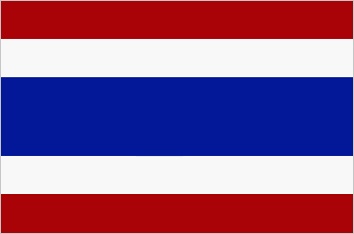Thailand, flag of
Flag History

national flag consisting of horizontal stripes of red, white, blue, white, and red. The flag has a width-to-length ratio of 2 to 3.
The original national flag of Thailand, in use from perhaps the 17th century, was plain red. When other states in the area displayed similar flags and commerce increased, it became necessary to add a symbol to the design for ready identification. In 1782 a white chakra (wheel), symbol of the ruling Chakri (Chakkri) dynasty (Chakkri Dynasty), was put on the flag of navy vessels, and in 1855 both navy and privately owned vessels displayed a red flag with a white elephant in the centre. The rare white elephant had long been a symbol of good fortune associated with the nation.
Thailand was one of the few Asian countries to escape European imperialism; however, its close relations with the West resulted in its becoming one of the Allies in World War I. To honour the relationship, King Rama VI (Vajiravudh) ( Vajiravudh) altered the national flag to a more “modern” design. On November 21, 1916, the elephant was replaced by two horizontal white stripes against a red background, and on September 28, 1917, the central red stripe was changed to blue. This gave Thailand a flag with the “colours of liberty” used by its allies Britain (United Kingdom, flag of the), France (France, flag of), Russia (Russia, flag of), and the United States (United States of America, flag of the). The navy adopted the same flag but added a red central disk with a white elephant, a design still in use today. Red is seen as a symbol of the blood Thai people have shed for their country, while white is for religious laws and the purity of Buddhism. Blue stands for the institution of royalty that guides the nation.
- Howard Pyle
- Howard R Garis
- Howard, Richard
- Howard, Robin
- Howard, Ron
- Howard, Roy W.
- Howard S. Becker
- Howard, Sidney
- Howard, Sir Ebenezer
- Howard, Sir Robert
- Howard Spring
- Howard Staunton
- Howard Thurston
- Howard, Trevor
- Howard T Ricketts
- Howard University
- Howard Walter Florey, Baron Florey
- Howard Walter Florey Florey, Baron
- Howard W. Odum
- Howe, Cape
- Howe Caverns
- Howe, Elias
- Howe, E.W.
- Howe, Gordie
- Howe, Irving